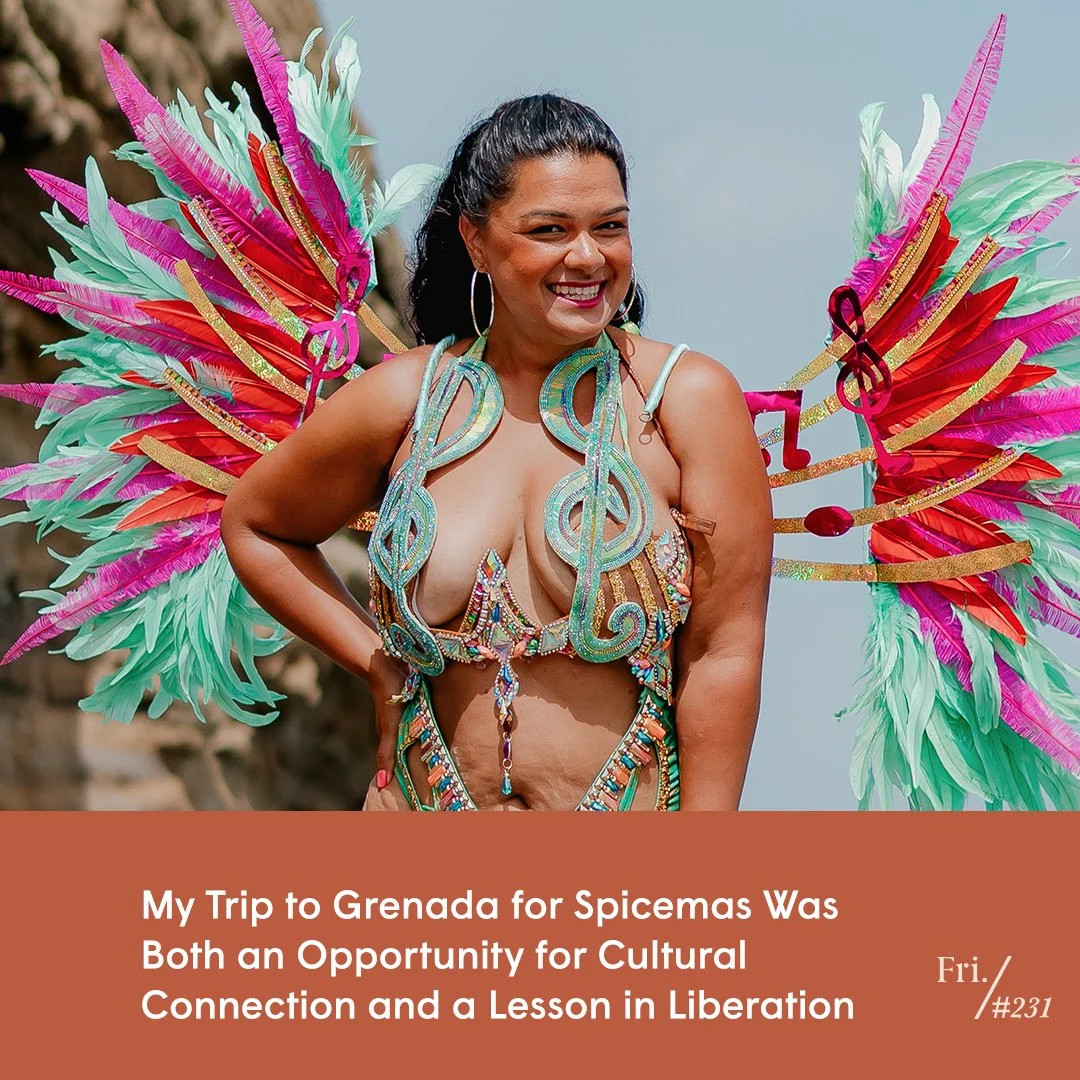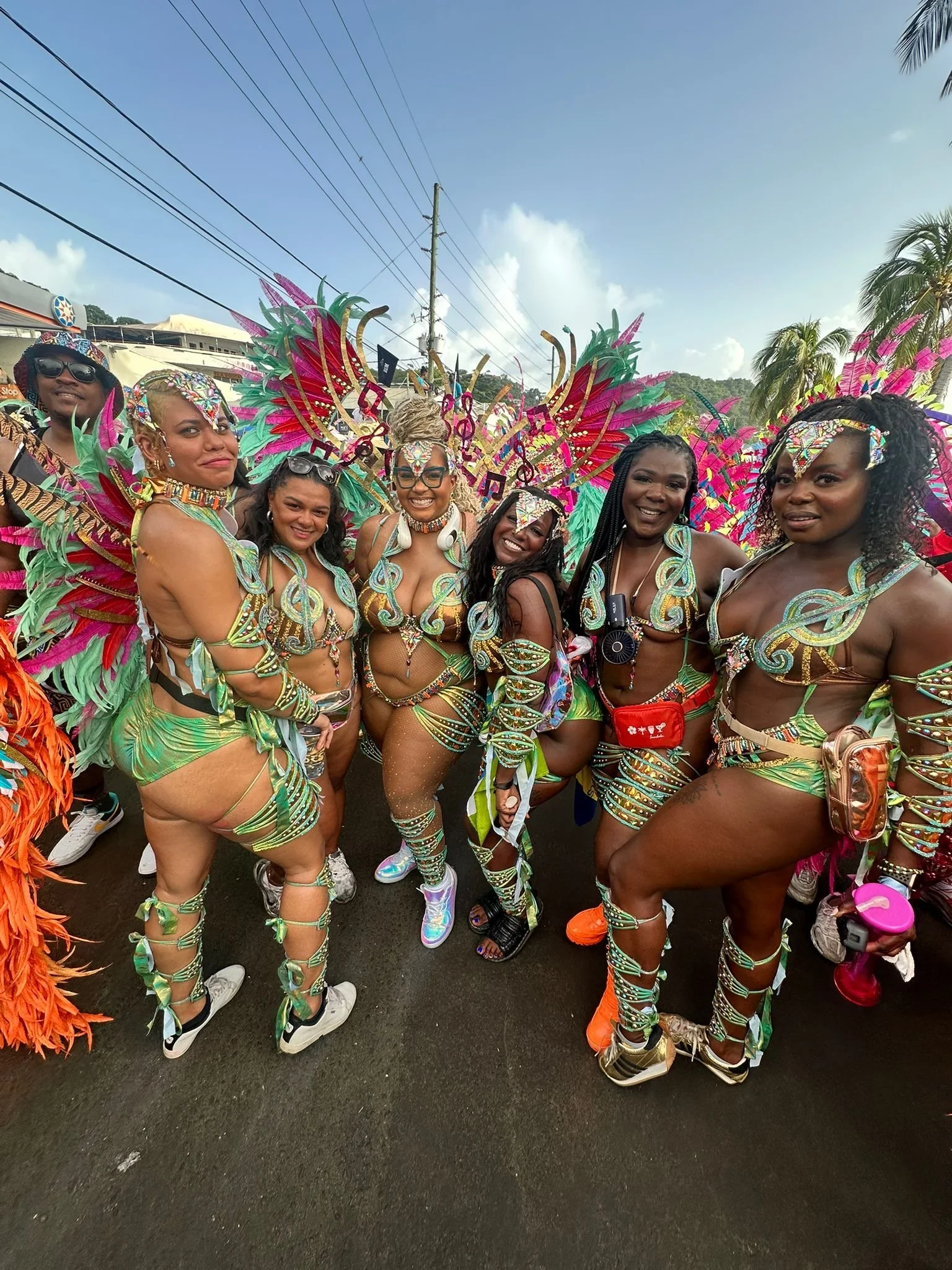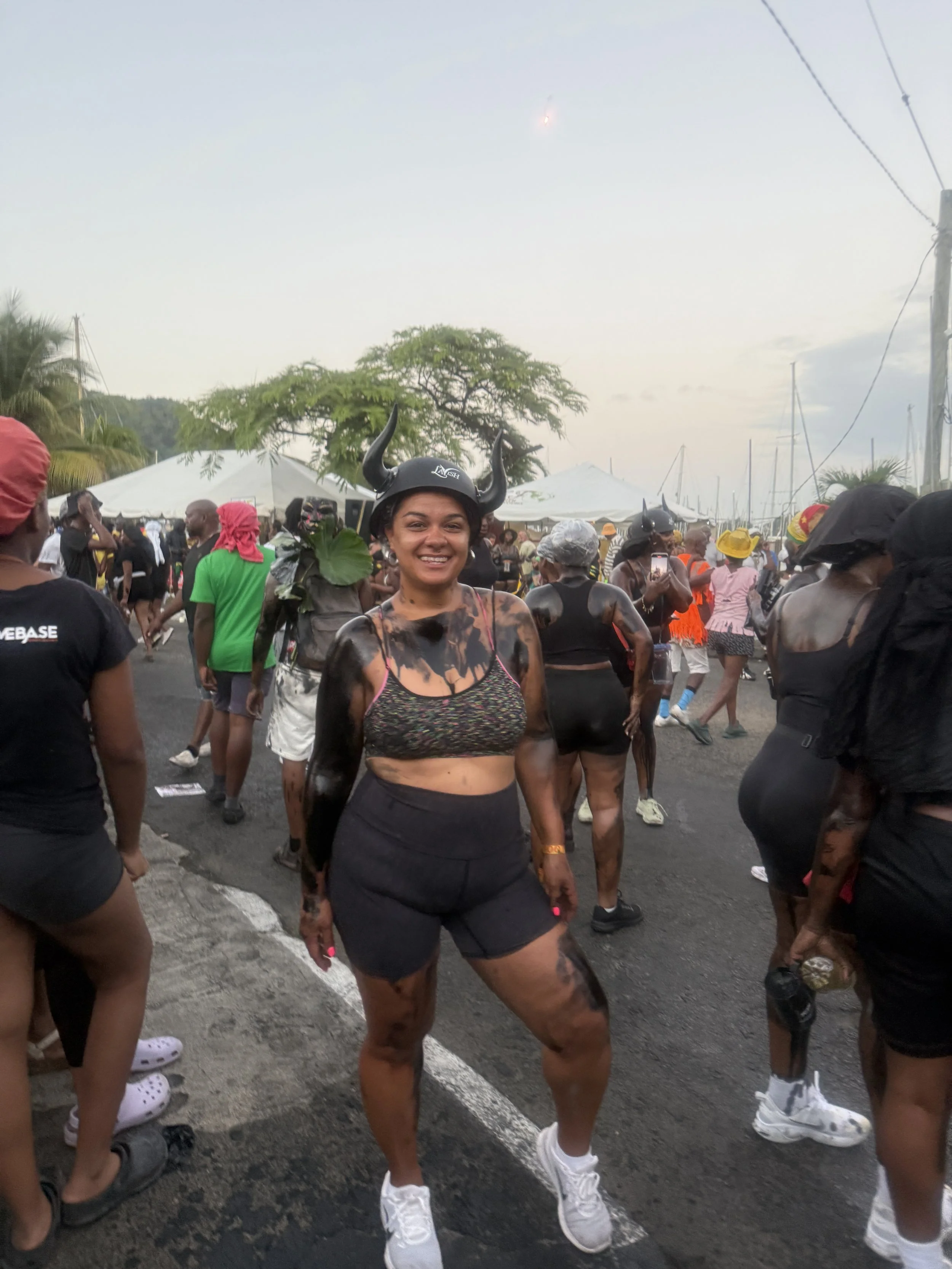Playing Jab at Grenada's Carnival Gave Me Access to a Different Type of Freedom
By Stacy Lee Kong
Image: Querine Salandy for Chambers Media Solutions
A core memory: It’s 4:51am on a Monday morning in early August and I’m in St. George’s, the capital of Grenada. Usually, the city is a charming hodgepodge of red-roofed buildings, colourful pennants strung between them, fluttering in the wind. But it’s J’Ouvert—the early morning kick-off to Carnival, and the first of several times that we will be playing mas over the next two days—and the streets have been transformed. Everywhere I look I see revellers, crowds of people covered head to toe in engine oil, pitch or charcoal, horned helmets on their heads and mouths dyed bright red with food colouring. Some are dragging heavy chains or coffins behind them, others wield DIY flamethrowers. There is no small number of men gripping octopuses between their teeth, tentacles spilling down their chests. The sun won’t rise for another hour, but already, huge music trucks are blaring Grenadian soca. People are dancing, drinking, smearing even more oil on one another’s bodies—and I feel so, so free.
“I don’t care, I making jab decision/Spicemas will never be a bad decision”
In 2021, Trinidadian American novelist Elizabeth Nunez wrote a column for Harper’s Bazaar about how thrilling it was to experience the freedom of playing mas during Carnival, something that felt all the more important because she hadn’t been allowed to do so as a child. Back then, her gender barred her from taking part in the celebration that her father and brothers got to revel in every year: “When I was a teenager, I was not allowed to jump up into the Carnival bands,” she wrote. “First, because I was female (oh, how much has changed!), and then, because I was female, I had to help my mother take care of my younger siblings. Not so for my brothers. Not so for my father. They were free to jump up in the streets from J’Ouvert (pronounced ‘Jou-vay’) to the close of Carnival the following night.”
Nunez, who died in 2024 at the age of 80, belongs to a different generation than I do, and the idea that it was improper for young women to play mas didn’t shape my childhood experiences the way it shaped hers. That being said, I did grow up in Canada without a lot of money and with very overprotective immigrant parents, which means we could never afford to be in Trinidad for Carnival and I definitely was not allowed to go to Caribana unsupervised. So, like Nunez, I also had to wait until adulthood to experience what it truly meant to be ‘on de road’—and I now feel a particular mix of gratitude, exhilaration and protectiveness around both Carnival itself and the role it plays in my culture. Because while it’s often perceived, and perhaps portrayed, like a bacchanalian street party that is more self-indulgent than spiritual, Carnival is a deeply meaningful experience that is—as Nunez hints at through her use of the word ‘free’—rooted in liberation.
Every Caribbean island has its own version of Carnival, but historians agree that it first evolved in Trinidad during the late 1700s. French slave masters had brought European Carnival traditions with them to the Caribbean, including holding masquerade balls in the lead-up to Lent. Of course, enslaved people were banned from participating, so they began organizing their own celebrations, which they used to mock their oppressors. Initially, they were known as ‘cannes bruleés’ (burnt cane), named for the enslaved people’s ritual burning of sugar cane, itself an act of resistance against the system of slavery that was oppressing them. Eventually, that name evolved into Canboulay, though the fundamental qualities of satire and mockery remained. Per a 2018 article in Edinburgh University’s Retrospect Journal, “one such form of mockery was the character called ‘Dame Lorraine.’ The Dame Lorraine costume would mimic the formal dress of the French women, and include exaggerated padding in the chest and rear along with wildly elaborate hats and fans. This costume was initially worn by men but as time passed, more and more women began to wear it.” Similarly, calypso, a musical genre that evolved from West African kaiso, was used as both a method of communication for enslaved people and a way to mock plantation owners and slave masters.
After emancipation in 1838, these traditions became even stronger tools of resistance—formerly enslaved people organized bigger, louder and bolder celebrations, which the British colonial government tried to suppress by banning drumming, masquerading, singing in public and the practice of any African religion. Unsurprisingly, while this did lead to the invention of the steelpan, it did not quash Carnival. In fact, in 1881, when colonial powers tried to further restrict Canboulay, people responded by rioting, which not only further established the celebration as an act of resistance but also inspired the development of many modern aspects of Carnival. On other islands, Carnival developed in very similar ways, from St. Vincent and the Grenadines’ Vincy Mas to Grenada’s Spicemas. Of course, regardless of the island, modern-day Carnival is often more focused on what we call Pretty Mas, with its feathers and sequins and glamour. But these traditional elements, and by extension the core value of liberation, are still fundamental parts of the festivities.
“They go have to put the jab jab on ah payroll, oil fresh like today old”
And frankly, they need to be. We still live in a racist, and specifically anti-Black, society, and Caribbean countries and their diasporas are still subject to colonial oppression, especially around tourism and exploitation. The struggle for our collective freedom is not historical; it’s ongoing. But for me, and I think for a lot of other Caribbean women, there’s another aspect of liberation that is an important part of our Carnival experiences: bodily liberation. As Nunez put it, “it may shock some sensibilities to see women dressed in costumes that are hardly more than string bikinis and men baring their chests and leaving their torsos scantily covered, but shock soon gives way to admiration,” she wrote. “For where else does one see men and women, particularly women, taking such joy in the shapes of their bodies? Such exquisite freedom! Big bellies, flat bellies, spreading behinds, narrow behinds—there is no body-shaming, just pure exhilaration jumping up in the Carnival bands.” I won’t pretend that playing mas has solved all of my body image issues; unfortunately, the 90s and early 2000s were just a little too damaging for that to be possible. But! Growing up seeing many, many different types of women—different sizes and shapes, yes, but also ages and skin tones—play mas in costumes that ranged from skimpy to full-coverage literally changed my understanding of beauty, and helped me see that, despite the societal rules and expectations that send the opposite message, I’m actually free to wear (and do!) whatever I want. Perhaps more importantly, it showed me that I inherently deserve to be free, and should expect to feel even freer as I age. And when I finally played mas for myself, which didn’t happen until my mid 30s, that message became even clearer.
This recent trip to Grenada has added another dimension to my understanding of Carnival, and my sense of liberation. There, Pretty Mas is secondary to J’ouvert, and especially to Jab Jab. This form of mas is also about mocking enslavers; as writer and culture critic Sharine Taylor explained in Yes Magazine last year, “prior to Grenada’s emancipation from slavery in 1838, enslaved Afro-Grenadian people were referred to as devils. As an act of satire, the enslaved rubbed any substance that would blacken their skin—molasses, tar, mud, or soot—over their bodies, made helmets emulating the devil with cattle or goat horns fastened onto a construction helmet (early iterations of the helmet were made from found materials such as the large posey bowls found on plantations), and walked around with chains. The Jab turned any descriptor deemed to be transgressive—being Black, being in chains, being the devil—into a symbol of rebellion, resilience, liberation, and freedom.”
In short: Jab Jab is deliberately, gleefully vulgar. It rejects colonial ideas of respectability, propriety and decorum. It is not ‘nice.’
That’s not to say there are no rules; the entire day is heavily guided by ritual. Traditionally, people wear old clothes that can be thrown away later. They rub a protective layer of lard (or, more commonly now, petroleum jelly) on their skin. Then, they apply engine oil or tar. They might carry those jawbones or octopus tentacles or chains that I saw on the road—all props to make themselves look more fearsome. For some, the ritual extends to their expressions, which are serious and unsmiling. For me, this felt like a deeper version of what I’ve experienced participating in Pretty Mas. While those experiences allowed me to feel beautiful, desirable and deserving of taking up space regardless of the ways my body and appearance deviate from Western beauty standards, this experience felt like freedom from performance entirely.
If we’re being very honest, my performance of femininity is more traditional than not. I like makeup and dresses and long hair; I’m a pretty soft person, and it took me a really long time to feel comfortable being assertive. I may not agree with (or like) ideas of respectability, propriety and decorum, but I am comfortable with, or at least practiced at, navigating them. So a type of mas that doesn’t just subvert but actually rejects those expectations felt both revelatory and powerful.
“We are the baddest jab”
Of course, there is still tension within this space. Jab Jab is often misunderstood and regularly criticized; the two main points of contention are allegations of hypersexuality, a critique that is leveraged against all forms of mas, and (apparently serious) fears that it constitutes demonic behaviour.
Ian Charles, CEO and founder of Jambalasee Grenada, is very clear in his defence of this longstanding cultural tradition: “The idea that Jab is devilish is Eurocentric propaganda,” he says. “A lot was done to demonize anything of African tradition. From drums to Jab to Maroons, the whole works. But it all falls under resistance and revolt. Jab resisted everything—religion, social, economic, cultural.”
But where he similarly insists that hypersexuality is not a traditional part of mas, I think it’s a bit more complicated. On one hand, and this is very heteronormative, I know, but: the idea of Carnival as a hypersexual space is a little bit funny, because men are so ancillary to the experience for me. Joking not joking, but they’re… kind of just there to wine on. It’s women who play a more important role; they’re the ones who help me adjust my costume, offer me water, share their alcohol, check to see if a man is getting too touchy, AirDrop me photos of myself, point me toward the food truck and otherwise offer me care, connection and safety. (Though obviously we have to acknowledge that even making this distinction this speaks to the danger of that ‘hypersexuality.’ Women who participate in Carnival, especially Black women, are objectified and sexualized, and face serious risks to their sexual health and physical safety.)
On the other hand, though, sexual liberation is part of Carnival, too. The entire practice has always been about rejecting limiting, false and harmful social norms. So, in a world where women’s desires are so often perceived as vulgar, this space can be one where it’s safe to express and have those desires met, in exactly the way and to the degree that you want. It’s about freedom, autonomy and choice—and what could be more in keeping with the spirit of Jab than that? In fact, there’s a really thoughtful TED Talk by Onika Henry, a Tobago-based Fullbright scholar and sexologist, who argues that “Carnival gives room for ‘differentness.’ It provides us with a framework or a context for letting go of a very limited and binary view of sex and gender.”
Even as someone who thinks about this stuff all the time, playing Jab was an urgent and necessary reminder of the ways that I personally need liberation, and by extension, the ways that my community is still not free. But it also offered me a different vision of what freedom could be like.
After four or five hours on the road, I was a mess. My clothes were drenched in a mixture of sweat and oil, and my sneakers were a lost cause. But I wasn’t thinking about any of that—not how I looked, or how I was going to get all of that oil off my skin, or even if I was hungry or my feet hurt. It’s not that my experience at J’ouvert wasn’t grounded in my embodied experience, because it was. But reflecting on it now, I think it felt so powerful because it also transcended the physical. It felt like liberation not just for one part of me, but for all aspects of my self.
And if that’s not an indicator that this practice is both liberatory and necessary, I don’t know what is.
Thank you for reading this week’s newsletter! Still looking for intersectional pop culture analysis? Here are a few ways to get more Friday:
💫 Upgrade to a paid subscription to support independent, progressive lifestyle media, and to access member-only perks, including And Did You Hear About, a weekly list of Stacy’s best recommendations for what to read, watch, listen to and otherwise enjoy from around the web. (Note: paid subscribers can manage, update and cancel their subscriptions through Stripe.)
💫 Follow Friday on social media. We’re on Instagram, YouTube and (occasionally) TikTok.
💫 If you’d like to make a one-time donation toward the cost of creating Friday Things, you can donate through Ko-Fi.



